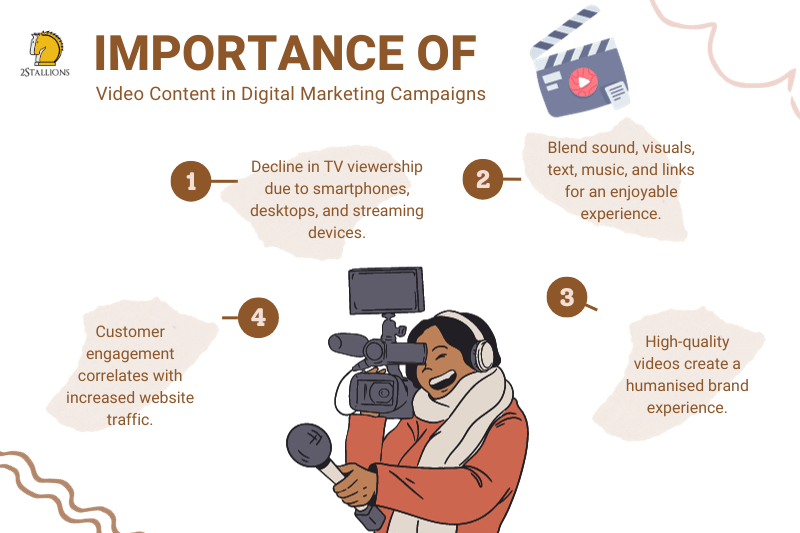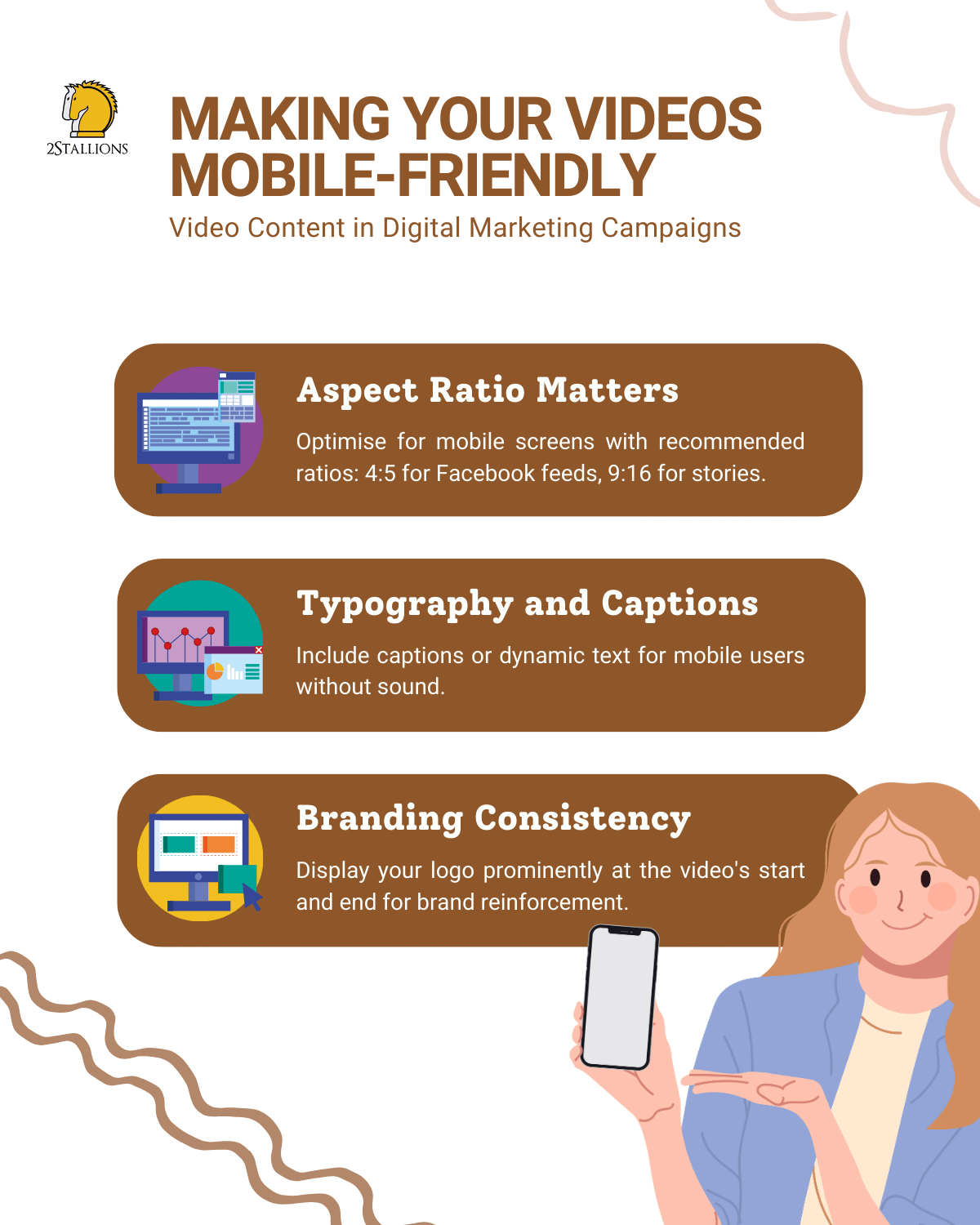SHARE

The future is already here, and marketers have had a full-on video revolution. Video and digital marketing are dynamic partners, like pen and paper or Batman and Robin, complementing each other to create art or improve the world. Without question, video marketing is one of the recent additions to our marketing toolkit, and any form of video (i.e. demo videos, video ads, how-to videos, explainer videos, etc.) can be a versatile marketing tool.
You may still have doubts. Is it worth considering using videos to market your brand? Do you have the necessary resources to generate video content? The answer is simple: Yes, it’s worth it. Videos can increase purchases, establish brand awareness, and widen a business’ customer reach, to name a few benefits. Video is one of the most influential and successful digital marketing techniques, not simply because everyone is doing it.
As a bonus, videos are also entertaining. Video content grabs people’s attention more than other media, often eliciting emotional connection, thus helping to drive more engagement. So, if you have not considered making videos for your brand, now is the time. Here are 4 reasons why video marketing campaigns are worth the investment and three reasons why you should start using video marketing now.
[thrive_leads id=’8354′]
Why Is Video Content Important
 1. Demand for Online Video Is Increasing
1. Demand for Online Video Is Increasing
The digital landscape is witnessing a monumental shift towards online videos, with 6 out of 10 individuals expressing a preference for online video platforms over traditional live TV, as reported by Think with Google. This transition has been fueled by the widespread accessibility of the internet and the emergence of a multi-platform environment.
In Southeast Asia (SEA), encompassing vibrant nations like Indonesia, Malaysia, the Philippines, Thailand, and Vietnam, YouTube emerges as the undisputed leader, becoming the primary choice for entire viewing sessions. This surpasses even the engagement on social media platforms by a substantial margin, indicating a transformative decline in conventional television viewership. The catalyst for this shift lies in the ubiquity of smartphones, desktops, and other devices, fostering a culture of streaming and social networking.
The demand for online video is not merely a trend; it’s an exponential surge. Daily, users consume over 1 billion hours of video content on YouTube alone, with 75% of all video plays occurring on mobile devices. Furthermore, the sharing culture surrounding mobile video content is evident, with 92% of users watching videos on mobile and willingly sharing them. The impact is also tangible, with pages featuring videos enjoying an average of 2.6 times more user engagement than those without.
2. Video Content Boosts Customer Engagement
 In the vibrant landscape of engaging Southeast Asia’s video audience, videos stand out as the ultimate content experience. They blend sound, visuals, text, music, and links, making information consumable and enjoyable. Unlike static text with limitations, videos bring messages to life through dynamic elements—movement, text, and sound. This becomes especially vital in a region rich in languages and cultures. To connect with SEA’s video enthusiasts beyond mere content delivery. Embrace creative collaboration with local talents and invest in innovative storytelling. This respects cultural nuances and ensures your brand resonates authentically in this dynamic and diverse market.
In the vibrant landscape of engaging Southeast Asia’s video audience, videos stand out as the ultimate content experience. They blend sound, visuals, text, music, and links, making information consumable and enjoyable. Unlike static text with limitations, videos bring messages to life through dynamic elements—movement, text, and sound. This becomes especially vital in a region rich in languages and cultures. To connect with SEA’s video enthusiasts beyond mere content delivery. Embrace creative collaboration with local talents and invest in innovative storytelling. This respects cultural nuances and ensures your brand resonates authentically in this dynamic and diverse market.
 Platforms like YouTube are pivotal in connecting with Southeast Asia’s video enthusiasts. In Vietnam, 64% of YouTube viewers prefer watching content with family and friends, underscoring the importance of relatable and resonant content. A similar trend is observed in Indonesia, where 67% of surveyed individuals actively utilise short-form video apps for discovery.
Platforms like YouTube are pivotal in connecting with Southeast Asia’s video enthusiasts. In Vietnam, 64% of YouTube viewers prefer watching content with family and friends, underscoring the importance of relatable and resonant content. A similar trend is observed in Indonesia, where 67% of surveyed individuals actively utilise short-form video apps for discovery.
3. High-Quality Video & Content Builds Better Brand Authority
Video content has proven to be more engaging and emotionally resonant than any other form of media. YouTubers have emerged as potent advocates for brand promotion. Recognising the significance of content marketing requires a corresponding commitment to incorporating video into the strategy. Promotional videos are crucial in establishing trust, especially for customers hesitant about online transactions. Addressing concerns about fraud and cheating, effective marketing videos conversationally showcase products, instilling greater confidence in online purchases.
The impact of high-quality, informative, and visually appealing videos extends beyond mere attention-grabbing; it contributes to building better brand authority. Videos create a meaningful and humanised experience for the audience, establishing a connection that resonates with consumers’ emotions. Successfully tugging at heartstrings enables a brand to capture and retain audience attention, enhancing brand authority and a positive brand image.
4. Compelling Videos Drive More Search Traffic to Your Website
Unlike text-based content, videos have an inherent ability to foster engagement due to their entertaining nature. They entice site visitors to linger longer on a page, drive social media shares, and, most importantly, encourage viewers to take profitable actions. This, in turn, propels businesses into the digital spotlight, improving their search engine optimisation (SEO) ranking and overall digital visibility.
Compelling statistics substantiate the impact of videos on SEO rankings. In 2022, online videos account for 82% of all internet traffic. Moreover, incorporating videos into various aspects of digital presence leads to a 157% increase in organic traffic from search engine results. Landing pages featuring videos are also 53% more likely to appear on search engine results pages (SERPs). Blog posts with video content attract three times as many inbound links as those without, showcasing the influential role of videos in online visibility.
In conclusion, the importance of video content in the digital realm is multifaceted. Videos have become a cornerstone of contemporary digital strategies, from meeting the rising demand for online videos to fostering customer engagement, building brand authority, and driving search traffic. Acknowledging and harnessing these trends is not just advisable but imperative for those seeking a competitive edge in the ever-evolving digital landscape.
How Do I Make Good Video Content
Creating compelling video content is essential for maximising the benefits of video marketing. To guide you in this endeavour, we’ve outlined 3 key best practices to ensure your videos stand out and resonate with your audience.
Edit for Engagement:
In the realm of video content, engagement is the currency of success. From the duration of your video to how you weave a narrative, every element plays a crucial role in keeping your audience hooked. In this section, we delve into the art of editing for engagement, offering insights into video length, transitions, visual effects, and the subtle balance between promotion and storytelling:

- Keep it concise: Aim for a 2-minute duration to maximise engagement. Deliver content that is concise, informative, and entertaining.
- Quick transitions: Recognise the short attention spans of viewers. Condense your key points within a 2-minute timeframe, maintaining viewer interest.
- Visual appeal: Enhance engagement with captivating effects, graphics, and animations. Create a visually stimulating experience for your audience.
- Call-to-action (CTA): Always incorporate a clear CTA, guiding viewers on the desired action. Encourage actions like joining a conversation, entering contests, filling out forms, or posing questions. Maintain a storytelling approach to avoid coming across as “salesy”.
Make it Search Engine-Friendly:
In a vast digital landscape, ensuring your videos are discoverable is paramount. This section focuses on strategically optimising your video content for search engines. From selecting relevant keywords to the importance of video transcripts and compelling thumbnails, we explore tactics to enhance your video’s visibility and accessibility across various platforms.

- Optimise for keywords: Research and include popular keywords in your video title and description to enhance discoverability.
- Video transcript: Improve searchability by including a video transcript, enabling your page to rank for a broader range of queries.
- Strong thumbnails: Boost click-through rates using custom human thumbnails, which have been proven to increase pay rates by 30%.
- High resolution: Increase visibility on YouTube by uploading videos in high resolution, as HD videos are more likely to appear on the first page of search results.
Optimise for Mobile Devices:
As mobile devices increasingly dominate video consumption, tailoring your content for these platforms is non-negotiable. Here, we explore the intricacies of optimising your videos for mobile, covering aspects such as aspect ratios, typography, captions, and consistent branding. Understanding and implementing these mobile-friendly practices will ensure your content resonates seamlessly with the on-the-go audience.

- Aspect ratio matters: Optimise your video for mobile screens by adhering to recommended aspect ratios. For Facebook, consider a 4:5 ratio for feed placements and 9:16 for story placements.
- Typography and captions: Accommodate mobile users by incorporating captions or dynamic text, as not everyone has sound enabled while browsing on mobile devices.
- Branding consistency: Ensure your logo is prominently displayed at the beginning and end of the video. Maintain visibility, even in thumbnails, to reinforce brand identity.
By following these best practices, you’ll create engaging and discoverable video content and optimise it for the ever-growing mobile audience, enhancing the overall impact of your marketing video efforts.
Final Thoughts
Video content production takes great planning and coordination between various teams. You will need experienced creative directors to develop your brand messages, lighting professionals to illuminate the video aspects you need, and a good post-production team to ensure high-quality videos. Most importantly, you need the help of a digital marketing agency to distribute your videos online and increase your online presence.
At 2Stallions, we not only help our clients determine the proper distribution channels, but we can also provide fresh ideas and visual concepts to engage your audience and keep them coming back for more.
Originally published: 14 June 2018
Updated: 5 January 2024
Revolutionise your online presence with 2Stallions, the top-notch content marketing firm! Unlock the power of content marketing to elevate your brand’s visibility to new heights. Don’t miss out on the chance to partner with us today and dominate your market!
Frequently Asked Questions About Video Content in Digital Marketing Campaigns
How Can Video Content Enhance My Digital Marketing Campaign?
Video content enhances digital marketing campaigns by providing a visually engaging and dynamic way to convey messages. It captures attention, communicates brand stories effectively, and encourages higher user engagement, increasing brand awareness and conversion rates.
What Types of Video Content Are Most Effective for Digital Marketing?
The effectiveness of video content depends on the campaign goals and target audience. Popular choices include explainer videos, product demonstrations, testimonials, and storytelling videos. The key is to create content that resonates with your audience and aligns with your marketing objectives.
How Should I Optimise Video Content for Different Digital Platforms?
Optimising video content involves tailoring it to the specifications and preferences of each digital platform. Consider factors like video duration, aspect ratio, and content style based on the platform (e.g., YouTube, Instagram, LinkedIn). Customising your approach ensures the content performs well across various channels.
What Metrics Should I Track to Measure the Success of Video Content?
Tracking metrics is crucial for evaluating the success of video content. Key performance indicators (KPIs) include view counts, engagement metrics (likes, shares, comments), click-through, and conversion rates. Analysing these metrics provides insights into audience behaviour and the effectiveness of the video in achieving campaign objectives.









